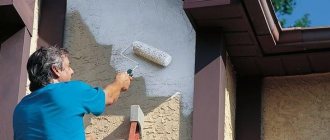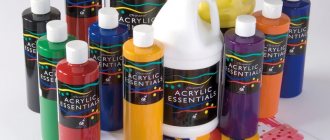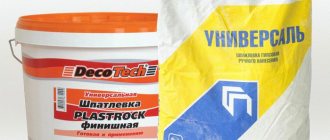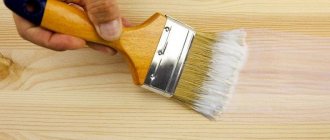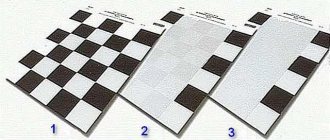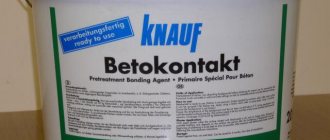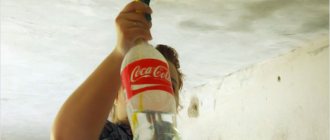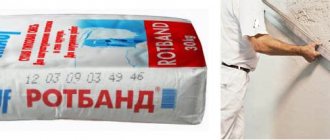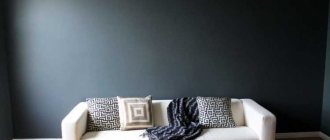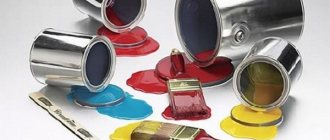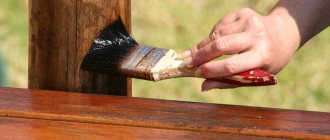You can use a thinner to thin dried paint within 5 minutes. They are also used to thin out cured paint left in unpressurized containers.
To make it, you need to prepare a pigment paste and then grind it. You will also need to add thinner.
Construction oil paints are used for wooden and concrete structures. In addition, they form a moisture-resistant layer on the surface. Among the advantages of such paints, it is worth paying attention to the simple application technology and affordable prices.
The designation indicates what type of drying oil is used as a substance for the suspension:
- MA - for natural ones;
- GF - on glyptal;
- PF - on pentagons.
Artistic oil paints are made from coloring pigments and oil (the classic version is linseed). Modern paints have a more stable and rich color.
Review of latex wall paint
In recent years, latex paint has increasingly become used when carrying out renovations in an apartment or other premises. And all because latex-based paints help maintain the necessary microclimate in the room.
They have all the necessary safety certificates, fully comply with GOST, and their price is within affordable limits.
What it is
Latex paint is a solution that consists of enamel made on a water-dispersed base. Its main component is natural latex, which provides a high level of protection from various types of exposure. This component by its nature is the juice of rubber plants.
If you use this element to make paints, then the cost of such material will be too high. To make it more accessible, it was decided to use synthetic polymers, which have an affordable price.
Despite the fact that latex paints are characterized by a liquid state that contains water, this does not allow the polymer particles to dissolve and stick together. After applying this solution to the surface, the liquid simply evaporates for some time. As for the polymer particles, they gradually begin to approach each other, and eventually stick together. After the water has completely evaporated, the surface dries and is covered with a continuous film, the adhesion to the surface of which is quite strong.
Latex based paint
This paint can be used to paint all available surfaces: concrete, brick, plastered and wallpapered. It can also be used to paint the ceiling.
Latex paint is available in white color and, with the help of coloring pigments, acquires the desired shade during the process.
Today, the most popular is water-based paint, which dries very quickly. A second coat can be applied 20 minutes after applying the first, and complete drying occurs in about an hour. This paint is odorless, environmentally friendly and safe for humans.
There is nothing complicated about gluing non-woven wallpaper. See for yourself.
Read about how to hang vinyl wallpaper here.
We make the walls soundproof with our own hands. The instructions are there.
Tinting of the composition and its decor
As a rule, all water-based paint goes on sale in a neutral color. It is based on a white palette. To give the composition the required shade, you must separately purchase a special coloring pigment.
It is introduced into the paint drop by drop. In this case, it is necessary to continuously mix the composition. It is better to do this with a mixer. Having achieved the desired shade, check how the mixture looks on the surface. To do this, paint a piece of the desired material.
Adding colored pigment to paint Source waysi.ru
But if, after adding color, it becomes necessary to dilute the paint with water, then this process will slightly lighten the composition. It should also be remembered that if several compositions are painted with different pigments, then do not forget to thoroughly wash the mixer attachment between operations.
In addition to changing the color of the base composition, modern technologies can improve the quality of the coating. For this purpose decoration is carried out. And this can be done in two ways. If a soft effect is required, then the substance is added directly to the palette before painting. When you need to clearly emphasize all the nuances or focus on the decor, it is applied from above, after painting.
The most popular are mother of pearl and glitter. They are introduced into the palette in portions, constantly mixing the composition. It’s better not to be lazy and check the concentration after each addition. To do this, look at how the surface will look after painting. The decor continues to be introduced in parts until the desired result is achieved.
Adding mother-of-pearl to paint Source vseprokrasku.ru
Tikkurila latex paint
Very often, when carrying out repair work, latex paints with a soft silk shine are used. This is exactly the kind of paint that the famous one produces.
This paint is odorless, solvent-free and environmentally friendly. It has established itself as a paint that can be used in children's and medical institutions.
Perfectly applied on concrete, plastered walls, as well as on fiberboard and chipboard surfaces in dry rooms. Easily tinted to the desired shade. Its consumption varies depending on the surface, approximately 1 liter per 7-9 m2. Dries completely in a couple of hours.
Solvent for silicate compounds
Silicate paints belong to the category of mineral paints, since the basis for them is liquid glass. They are fireproof, breathable and weakly resistant to moisture. Can be used for finishing plastered, stone or concrete surfaces indoors and outdoors. To dissolve this type of coating, you do not need to resort to the use of aggressive substances with pungent odors. It is enough to use a silicate primer, which can be found in any hardware store.
Latex washable
This type of paint is intended for interior and exterior use.
Used for painting ceilings and walls in rooms with high levels of humidity and intense load.
It can also be used for painting glass wallpaper and other surfaces with a non-woven base.
Before starting work, it is necessary to carefully prepare the surface and pre-prime it. If there are cracks and potholes, these should also be repaired.
In order to achieve the required paint viscosity, it can be diluted with water. Apply with a roller or brush in one or two layers.
You can read about the benefits of garage flooring here.
Is it possible to glue new wallpaper onto old ones? Of course, the main thing is to know how.
All information about installing sliding doors is here.
Benefits of use
Like any building material that is used for home renovation, latex paints have a number of positive characteristics, thanks to which they are in demand among a wide range of consumers.
Let's highlight the main advantages of latex paints:
- Any surface can be finished with latex paint. The solution fits perfectly on the walls, regardless of the method of its application.
- After painting, the coating is of high quality and durable, unlike the results of other paints.
- High level of environmental friendliness. Since the mixture contains no harmful components, the use of such material is absolutely safe . Such paints can also be used for rooms with high design requirements.
- You can create your own individual shade yourself. This is justified by the fact that the paint itself is white, and different colors are used to change the color.
- Economical. Since only 0.1-0.5 liters of solution are required per 1 m², this consumption is quite small. This indicator may vary slightly, it all depends on the quality of the surface being processed.
- Democratic pricing policy. Unlike the cost of oil-based enamel, latex paints are cheaper.
- High level of vapor permeability. Thanks to this property, the formation of condensation under the coating is excluded.
- After painting, a durable and resistant coating is obtained.
- The drying period of the paint is relatively short.
- Simplicity and ease of care. In case of contamination, the surface can be cleaned with a damp cloth.
Latex for walls and ceilings
For interior decoration, water-dispersion latex paints are mainly used.
After all, they have a number of positive qualities: fire safety, non-toxicity, strong durable coating, easy to use. Plus, this paint ideally combines quality, performance characteristics and an affordable price.
Due to the fact that it is applied to various surfaces, including primer, plaster and wood, it contains a special substance that greatly simplifies the application process and improves adhesion.
After complete drying, they can not only be washed, but also cleaned. The surface is breathable and elastic. This paint dries in 5-6 hours, provided that the room temperature is not lower than 12 degrees.
To obtain the required viscosity, the paint must be diluted with water in a ratio of 1 liter per 6-9 m2 per layer.
Here you will learn about leveling the ceiling with plaster (video) and other useful tips.
Find out how to soundproof walls here.
Types and features of water emulsion
The paint is based on a water suspension with tiny particles of polymers. And besides this, the composition includes up to 15 types of additives. After all, in order for the water-based emulsion to look good and stick to the surface, it must contain a plasticizer and thickener, a preservative and antiseptic, a dispersant and a corrosion inhibitor.
In addition, substances are needed that will increase structural viscosity. And at the same time they will reduce the ability to foam. And the amount of all these substances directly depends on what film former (copolymer) is used.
A wide range of water-based paints Source novosibirsk.vse-kraski.ru
The following dispersion can be used as a copolymer:
- versatovaya;
- acrylic;
- styrene-acrylate;
- styrene butadiene;
- latex;
- silicone;
- silicate;
- polyvinyl acetate.
It is because of the film former used that the purpose of the coloring composition changes. But in any case, it requires fillers. And mica and talc, barite and calcite play an excellent role in this role. But most often they use regular chalk to reduce the cost of the product.
Water-based paint with acrylic polymers Source farben-trefz.de
But in order to dissolve all these components, you need water that is completely purified from all salts and minerals. And in order to understand how to dilute water-based paint without losing all its positive qualities, you need to pay attention to its composition.
Polyvinyl acetate structure
Used for coloring all porous materials. From cardboard and wood to plastered walls. The paint is based on PVA glue and the composition is revealed 100% only in dry rooms, the air temperature of which does not exceed 27 °C. Not suitable for outdoor work at all.
Polyvinyl acetate based paint Source mrrestavrator.ru
When hardened, a semi-matte layer is formed, which is characterized by some porosity. This allows the water in the paint to evaporate faster. And the addition of the latter must be carried out strictly in accordance with the instructions from the manufacturer.
The main advantages are:
- The working composition is easy to apply, as it is easy to dilute with water to the desired consistency.
- No unpleasant odor because no toxins are used.
- Fire safety and UV resistance.
- Resistant to alkalis and mold.
Disadvantages include intolerance to low temperatures. Already at +6 °C there is a drop in all positive characteristics. And although the composition is considered moisture resistant, it is better not to use it in rooms with high humidity.
Application of paint based on PVA glue Source kraski-net.ru
Acrylic water-based composition
Thanks to the introduction of acrylic polymers into the paint structure, it acquires universal properties. The mixture fits well not only on porous surfaces, but also on metal and even glass. This creates a strong film that acts as reliable protection for a long time.
For the production and dilution of paint, only distilled water is used. And the composition is suitable not only for interior work, but it can be used to paint outdoor surfaces. You just need to check the manufacturer's instructions.
This product has more advantages:
- For quick drying, +15 °C is enough indoors and outdoors.
- The finishing layer is not afraid of sunlight and is easily washed off from dirt.
- It is not afraid of frost and retains its qualities at -30 °C.
- Does not contain environmental substances harmful to health.
- The copolymer creates a film that prevents cracks from forming on the surface.
- The paint is not afraid of fire.
- Suitable even for bathrooms.
- The guaranteed service life of the surface is at least 8 years.
There is only one negative side, apart from the high cost. The paint has low vapor permeability. Therefore, its use in some cases comes into question.
Applying acrylic water-based emulsion to the wall Source waysi.ru
Latex structure
Paint with any emulsion, such as acrylic, silicone, styrene butadiene or polyvinyl acetate, is easy to make washable. To do this, it is enough to add latex to its composition. The substance forms a film on the surface that repels moisture.
By the way. The latter remains as a paint thinner, even though it contains latex. It does not affect the ductility at all until the finishing layer has completely hardened. A special crystalline structure is created that does not interfere with wet cleaning and allows the surface to breathe.
Washable paint with latex added Source waysi.ru
How to dilute latex paint (consumption)? Painting technology
Before starting work, it is necessary to dilute the paint with cold water in a ratio of 1 liter per 6-9 square meters. meters for the first layer. All subsequent layers of water will require less. More details can be found in the instructions for the paint used.
Before starting work, it is necessary to carefully prepare the surface, clean it of dirt and dust, and, if necessary, strengthen the surface to be painted with latex paint with acrylic impregnation. It will prevent the paint from cracking and crumbling during use.
If the paint needs to be applied to wallpaper, concrete or brick walls, then you can do without a primer.
The paint dries in 4-6 hours at a temperature of +20 degrees, and can bear the load after 2-3 days. Only after this can the next layer be applied.
Source
Rules for diluting paint with water
As a rule, problems await beginners who decide to do all the painting work themselves. After all, the process itself is not difficult. And difficulties arise only when bringing it to the desired consistency.
Let's look at how to dilute water-based paint:
- You should carefully read the manufacturer's recommendations on the packaging.
- Regardless of the instructions, do not add water to the paint in an amount exceeding 10% of the total volume of the palette.
- Use different proportions of water for each layer of paint.
The last point needs to be discussed in more detail. If you plan to apply at least three layers of paint for a better coating, then the first portion should be diluted thinner. This promotes better penetration into the pores and acts as a primer if it has not already been done. Therefore, when diluting for the first time, you need to add the largest amount of water that the instructions allow. Up to all 10%.
Applying the first layer of paint Source legkovmeste.ru
The second layer will require only 2-3% liquid. As for the topcoat, this portion does not need to be diluted at all. The latter also applies to the second layer, if the initial consistency of the palette is ideal. Excess water will only lead to loss of quality.
And it is not uncommon for a situation when, after diluting the paint, it is necessary to increase the number of layers in order to achieve the desired visual effect. And only unscrupulous hired contractors are guilty of excessive dilution, when the owners trust them with the purchase of materials. This makes it possible to increase the budget.
What to look for when choosing
Now, knowing what latex paints are, it’s worth deciding what you need to pay attention to when choosing a paint to decorate a particular area of a house or apartment.
- It must be said right away that latex paints intended for indoor use are not suitable for facade work, since they are unstable to external factors.
Therefore, the first thing you need to pay attention to when studying the packaging is what kind of work the paint is intended for, internal or external.
- Wear resistance of paint. Thus, compositions intended for coating ceiling surfaces have lower wear resistance, so they are not recommended for use on walls. As a rule, the manufacturer indicates on the packaging for which internal surfaces it is recommended to use this type of paint.
Latex paint intended for covering the ceiling. It is not advisable to use it for walls - the wear resistance of the coating is low.
- Degree of whiteness. This parameter is also indicated by the manufacturer on packages of white paint. So, for example, for the ceiling, it is worth purchasing super white paint, which is ideally white without a yellow tint. It is best to cover the ceiling with two layers, having previously calculated the amount of paint for a certain area.
- Glossy or matte paint. According to this parameter, the paint is chosen depending on what effect is desired to be obtained as a result. Glossy paints, after drying on the surface, give a characteristic shine that can somewhat hide small surface imperfections. Matte paint is usually applied to a perfectly smooth surface; it does not give shine, and therefore will show all the irregularities and scratches.
This property of the paint is also indicated on the packaging. In some cases, the manufacturer designates it as deep matte, velvety matte, silky matte or silky glossy. Since the matte type of paint is more popular, experts recommend choosing a silky-matte version.
The decorative qualities of silky-matte paints are much higher than those of simply matte paints. Such compositions give surfaces a more noble appearance, do not become so dirty and are much easier to clean. However, their cost is slightly higher than the price of paints that have a different surface effect.
- Covering power. This parameter is also worth paying attention to, as it will help save on paint consumption. This has already been discussed above.
- Paint consumption per square meter is a parameter closely related to hiding power. Also indicated by the manufacturer on the packaging.
- Moisture resistance of paint. If you plan to paint surfaces in the bathroom, then you need to choose compositions that indicate this particular quality of the solution. This paint is equipped with additives that make the coating hydrophobic and allow wet cleaning.
The price of latex paint depends on its qualities and manufacturer. For example, moisture-resistant and facade compositions have a higher cost. However, for reasons of economy, this is not a reason to purchase a conventional option for wet rooms or exterior decoration, since it will not last long.
Some experts recommend choosing imported paint or one that is produced in Russia under a license from a foreign company. These recommendations are explained by the fact that foreign manufacturers have more experience in the production of such products, they use proven, proven manufacturing technologies, and they are constantly working to improve the characteristics of the compositions. However, imported or licensed paint has a significantly higher price. And the original products of many Russian companies often compete almost equally with Western ones.
Useful tips
Over the years of using water-based paint, real masters have gained a lot of experience. Professionals do not hide their secrets and are ready to share them with beginners. Following the recommendations, novice artists will be able to avoid common mistakes, both when diluting paint with water and when subsequently applying the palette to the surface.
If after painting there is excess diluted paint left, then you should not rush to add it to the main one. This may affect overall properties. It is better to find a suitable container with a tight lid and store the leftovers in it. Having previously provided it with a homemade label on which you need to indicate the necessary information.
Usually the thickness of the paint is determined by eye. But you can use the same manufacturer’s recommendations that are indicated on the packaging. It indicates the degree of viscosity at which coloring will occur under the most optimal conditions. To determine it most accurately, you need to rent a special device from professional painters.
A device for determining paint viscosity Source aliexpress.com
The viscometer is made in the form of a funnel with a calibration hole. It's easy to use, but you'll need a stopwatch. A certain amount of paint is poured into the device, closing the lower hole with your finger.
Simultaneously clearing the passage and turning on the stopwatch, wait until the palette completely flows out of the funnel. The obtained figures are compared with those recommended on the packaging. And if they differ, then water is added to the paint. And the process is repeated again.
If you need to paint the ceiling, you should not make the composition too liquid. Excessive addition of water will cause the paint to lose its viscosity and simply drip from the ceiling. Therefore, for the ceiling, the palette is kneaded thicker.
Original wall design with paint drips Source avto.goodfon.ru
Don't listen to bad advice. There are “experts” who claim that you can speed up the drying of water-based paint if you dilute it with a chemical solvent instead of water. This will lead to trouble. The fact is that not all thinners collapse immediately. Many of them do this after a while, directly on the painted surface. In this case, the appearance of the material will be completely and irrevocably damaged.
Classification of materials
Latex paints may differ in composition, which determines the possibility of using paints and varnishes for interior or exterior work. Additives are added to compositions that can be used for exterior finishing to prevent the formation of fungus and mold. They are more resistant to ultraviolet radiation and precipitation. In addition, water-dispersion paints are classified into several types depending on the binder:
- Polyvinyl acetate. They do not contain solvents, are odorless, and dry quickly. Cons: washes off easily, is only suitable for interior work, can leave marks like whitewash.
Selection criteria for interior and exterior work
When choosing, you need to take into account the base material and operating conditions.
External painting of the walls of a house, architectural compositions in the landscape requires careful selection of the paint composition.
The material must meet certain requirements:
- resistance to chemical components dissolved in the atmosphere;
- endurance to impacts, friction, destruction from sunlight, wind loads;
- reliability during freezing and thawing during seasonal temperature changes.
For interior painting, environmentally friendly types are used. The choice depends on the type of surface, grain size, texture. The color of the material, its dullness or gloss, matters.
Exterior finishing
The basis of this type of paintwork material is a synthetic polymer that can be easily washed with water and soap. Thus, if latex paint gets on the windows during exterior work, it can be easily wiped off.
It can be applied to a slightly damp surface, which will be useful for repairs in the early morning, when the dew has not yet disappeared or after light rain.
Latex paints for exterior use are preferable to many other types, because they practically do not fade, which will be important in hot weather when a large amount of sunlight hits the surface. In addition, a special compound is added to the material for facade work to prevent the formation of mold.
The façade version of this coating material is highly wear-resistant, vapor permeable and does not allow excess moisture to pass through. In appearance it is smooth and matte.
One layer dries in about a day, depending on air humidity. It is applied in several layers with a break of 10 hours. Acrylic or acrylic silicate paint is suitable for facade work.
Step by step steps for diluting paint with water
It is necessary to prepare the container, since painting directly from a purchased container is not only inconvenient, but also completely wrong. Because to pass each layer you need to dilute a new composition. Therefore, it is better to take a separate container and pour the required amount of palette into it.
You need a mixing tool. To perform the operation manually, a small wooden stick with a flat blade at the end, in the form of an oar, is suitable. Mechanical processing facilitates and speeds up the process. A regular electric drill with a special attachment will help here.
Special mixer for paint Source samorez.by
Let's look at how to dilute water-based paint step by step:
- Pour enough paint from the purchased can into the prepared container to complete a full paint pass.
- Estimate the cast volume of the palette. It is better to take more precise measurements. And to make the operation easier, you can prepare the container by first making marks on it.
- Based on the thickness of the material, determine the required proportion and calculate the required amount of water.
- Take the required volume of already prepared liquid (distillate or boiled). And, if necessary, bring it to room temperature.
- Water cannot be poured into the paint all at once. It is brought in portions.
- After each addition, the palette is thoroughly mixed, ensuring uniformity.
After dilution is completed, it is necessary to check how the composition lies on the surface. It’s better not to try on the original, but to pick up a piece of similar material and paint it. If the thickness is desired and the paint does not leave streaks, then you can begin painting the desired surface.
Applying water emulsion to wallpaper Source kraski-net.ru
Marketing Title Table
| Name | Compound | Peculiarities |
| Water-dispersed | Butadiene-styrene dispersion composition | The durability of the coating is higher than that of polyvinyl acetate compounds, but lower than that of acrylic compounds; affordability |
| Acrylic using latex technology | Dispersion based on polyacrylates with the addition of latex of various origins | Durable coating plus cost reduction due to the addition of styrene-butadiene component |
| Acrylic with latex-free technology | High-quality polyacrylate base without dispersion latex component | Produced exclusively in the USA, it is highly durable and highly priced |
| Acrylic with latex added | Contains acrylic copolymers in combination with butadiene styrene | No different from acrylic paint using latex technology |
| Water-based | Composition of water and particles of coloring matter - latex | Same composition as water-dispersed latex |
Conclusion: if it’s on the can, it’s a durable composition at an affordable price with optimal consumption. The difference between water-based and water-dispersion latex paint for ceilings and walls from acrylic paint is a shorter service life and lower resistance to various negative factors.
On the video: water-dispersion paint and its features.
Operating principle
To understand this process, you need to know which component is the main one in a particular coloring composition. Consequently, the solvent is selected with a similar composition. When you add it to dried paint, it will complement its composition and replenish the evaporated part of the base. Thus, you will be able to achieve almost its original condition. The main thing is to thoroughly mix the components together, reaching to the very bottom, so that the solvent does not float on the surface and the composition becomes uniform in thickness.
Basically, all interior paints are sold ready-to-use and do not require additional dilution.
Only in the cases described above. There are a few simple rules that you can follow to achieve the best results:
- The dishes in which you will do the work must be clean. No dried paint fragments from previous uses and no small debris. Rinse it with water and wipe dry.
- The most suitable containers are those that have a cylindrical shape with smooth walls. In such a vessel you can move the components as evenly as possible.
- If we are talking about paints that must be diluted with water, then its part should be no more than 10% of the total mass.
- In alkyd enamels that will be used for exterior work, it is necessary to add no more than 3% of the total amount of liquid.
- For interior work – no more 5%.
If you add too much solvent, your paint will not adhere and will simply run off the surface being treated. This is especially true for vertical planes, on which drips instantly form. At the same time, the performance indicator and service life of the coating are reduced Let's take a closer look at the most common types of interior paints and the types of solvents suitable for them.
Effects on a painted surface
Latex paint creates some effect on the treated base - matte or glossy surface, semi-matte or semi-gloss effect, perfect gloss or perfect matte. It is necessary to take into account gloss parameters, especially for interior work. Too shiny walls and ceilings make the visual perception of the room tiresome. Glossy latex paint has the following advantages:
- Moisture-resistant white paint visually expands the size of the room, “pushes” the walls and “raises” the ceiling.
- Requires ideal surface preparation before painting, does not hide flaws and irregularities.
- Less susceptible to contamination, hides traces of dust and dirt.
- Partially loses its attractive shine when washed and wears out over time.
Matte paint, in contrast to glossy paint, has the opposite properties - it visually reduces space, is less easy to clean from dirt, hides defects in the base surface well, and wears out less during washing and maintenance. Semi-gloss, semi-gloss and matte paint is the most suitable option for decorating walls and ceilings. The main advantage of all latex compounds is high permeability. Walls, ceilings and other painted surfaces “breathe” well under a layer of paint and varnish.
Properties
Reflectivity is also important for interior design. Two opposites – matte and glossy surfaces.
The paint can withstand high temperatures, is completely non-flammable and neutral to chemicals.
Note! The degree of gloss or matte is indicated in the technical description. Sometimes or “silky-glossy” (satin).
There are 6 degrees of light reflection:
- coefficient 90-100 – SG marking (super glossy);
- 60-90 – G (glossy surface);
- 30-60 – PG (semi-gloss);
- 11-30 – PM (semi-matte);
- 6-10 – M (matte);
- from 0 to 5 – SM (completely matte).
Light-absorbing surfaces better hide minor wall defects. Maximum gloss is suitable for a perfectly smooth ceiling - it will be almost mirror-like, which allows you to visually enlarge the room.
The paint is available in various gloss levels, which range from 0 to 100.
For southern rooms, you should not purchase a high gloss factor, especially in a children's room, the glare will be blinding. Likewise, matte wall painting can absorb some of the penetrating light on the north side of the house.
Latex paint is presented in a wide range on the modern construction market.
Substrate preparation and painting
Using interior latex paint is an environmentally friendly way to decorate rooms. The compositions do not contain toxic substances, dry quickly and do not leave a characteristic odor in the rooms.
Water-dispersion paints can only be diluted with water – not technical water, but drinking or purified water. It has an optimal stiffness index.
There is no fundamental difference when painting walls and painting ceilings with latex paint. The only condition is that ceilings can only be treated in rooms that are heated in cold weather, otherwise the coating will quickly crack. Can be used in damp rooms. The work consists of the following stages:
- Prepare the surface for painting - remove the old coating, level the base with putty.
- Treat the walls or ceiling with a deep penetration primer twice with drying intervals.
- Dilute the composition with cold, clean water - for the base layer, use 1 liter of water per 6-9 square meters. walls (ceiling).
- Leave for a few minutes and add coloring paste. Dilute with a reserve - it will not be possible to repeat the shade exactly.
- Paint the surface with a diluted composition using paint brushes, rollers or a spray gun - there is no fundamental difference.
- After drying at a temperature of +20°C, the base coat is painted a second time, and if necessary, a third time.
Preparing water for entering the palette
Since the use of water-based paints, many experiments have been carried out to improve its application. Craftsmen introduced various chemical solvents into the paint to dilute it. Thus, wanting to improve the properties of the coloring mixture.
But in most cases this led to the latter simply collapsing. Lumps formed in it, which subsequently completely refused to dissolve. And the composition lost all the necessary properties. Therefore, experts unconditionally say that the only correct solution is to use water. Because it acts as the basis of the palette.
Distilled water for diluting paint Source arteziano.ru
But before diluting water-based paint, you need to make sure that the liquid meets the required parameters. First of all, pay attention to the ambient temperature. Because the coloring composition tends to thicken faster at low degrees, and literally turn into water in high heat.
Therefore, during interior work, it is always checked that the water is at room temperature. This will prevent a lot of unnecessary problems. But outside it is recommended to use slightly heated water. This technique will slow down the thickening of the composition, which occurs faster in the open air. True, the method should only be used in cold weather.
Heating water for diluting paint Source proctologi.com
The second serious factor that can impair the quality of painting is the presence of impurities. After all, water perfectly dissolves everything that is introduced into it. And if not completely, then it is still enriched by the elements that got into it.
And this will have a detrimental effect on the characteristics of the palette. Its color may change or the necessary properties may decrease. Therefore, the best way out would be to use distilled water. There is no need to prepare it yourself by running it through a homemade apparatus. It is sold in all auto stores and most hardware stores.
But you can still remove all unwanted impurities from ordinary water at home. To do this, just boil it and let it settle. At the same time, it reaches the desired room temperature on its own. After this, you just need to carefully pour it into another container so that all the sediment remains in the original container.
Preparing water for diluting paint Source legkovmeste.ru
Recommendations for the process of painting surfaces with latex paint
Experts recommend adhering to some rules for working with latex paints, which will help make the coating more reliable and durable.
- When preparing the surface for painting, it must be thoroughly cleaned. If the walls are loose, they must be strengthened with a deep penetration primer. Then the surfaces are leveled using putty, sanded and always cleaned of dust.
- It is not recommended to prime a leveled surface for latex paints with non-adapted compounds, as there is a risk of excessive application of primer, which will create a durable film. As a result of this, the coloring composition will apply unevenly, and serious defects will appear in the lining. Instead of primer, to prepare the surface it is better to use paint diluted with water in a ratio of 5:1 - it will serve as a primer and the first layer of paint.
- It is best to apply paint using several painting tools - a roller and brushes of different widths. It is convenient to cover large areas with a roller, and hard-to-reach places with brushes - corners, as well as the space around radiators.
When performing finishing work, you should achieve the most even distribution of paint over the surface.
- To ensure even coloring, the surface should not be painted in separate sections. If the ceiling is being painted, then the roller must be applied from wall to wall, and if walls, then from floor to ceiling.
- You should not use a foam roller attachment for painting, as it leaves air bubbles on the surface that can create unevenness in the paint.
- It is necessary to apply and roll out the paint quickly enough to prevent smudges and sagging.
- Each layer applied to the surface must dry thoroughly before the next one is applied to it.
What tools will you need?
- ladder
- tray
- roller and brush
- sandpaper
- overalls and safety glasses
- film for protecting various objects in the room and the floor from dye ingress
Note: it is better to choose a fleecy roller for painting the ceiling with water-based paint. The optimal width is 20-25 centimeters. It is better to avoid all other types of rollers: foam rubber will significantly bubble the surface, and velor will slow down the work due to the low absorption of paint. As for the brush, prefer a comfortable, thin brush that can quickly and efficiently paint edges and corners without any problems. The recommended width is no more than 8 centimeters.
Application for ceiling
The most commonly used color for ceiling coverings is white; it matches different colors. If we talk about which paint is better, acrylic or latex, then you need to understand that you can get different effects from the latter. The ceiling can be matte or glossy. To figure out what kind of coating you will get, study the manufacturer’s instructions on the packaging; the level of dullness is indicated in numbers.
Gloss on the ceiling covering will benefit, it helps create the following effects:
- The height of the ceiling visually increases; a similar effect is obtained due to the fact that light rays are reflected from the glossy surface. And designers often use a similar technique for low rooms to make them more comfortable without being overwhelming;
- The glossy finish collects less dust, it is easier to clean, and for white color this is important, you can enjoy the whiteness for a long time.
However, gloss highlights all the imperfections of the coating; for this reason, leveling the ceiling covering should be done carefully and efficiently so that the paint layer does not highlight these imperfections.
The color most often used for ceiling coverings is white.
In what cases is it necessary to dilute the composition?
Before diluting water-based paint, you should always read the manufacturer's instructions on the packaging. From the name of the product, it becomes clear to most users that it can be diluted with water. But there may be serious restrictions, both in the quantity and composition of the liquid. And a reliable, reputable manufacturer always honestly warns about all cases.
Detailed instructions for using paint from the manufacturer Source homemasters.ru
In order to determine the need to dilute the water-based emulsion, it is enough to pay attention to its thickness. It depends on how much water was placed in the composition during manufacture or how much of it has already evaporated. And paint with the viscosity of thick sour cream usually goes on sale.
The jar with the coloring composition is opened and the contents are thoroughly mixed. This must be done with a wooden oar and for at least 5 minutes. The working density is determined by the flow of the composition from the mixer. If, when lifting the oar above the surface, the paint remains on it in the form of a thick layer, then dilution with water is required. When the liquid quickly flows back into the jar and only a thin layer remains on the surface, then you can immediately work with the composition.
Determining the density of the palette Source design-homes.ru
The need for dilution is influenced by the method of application to the surface. To work with a brush or roller, the consistency of the product must be sufficiently viscous. This is required to ensure uniform application and eliminate paint smudges on the surface.
When choosing a spray gun, the paint must be brought to a state in which it can easily pass through the nozzle. And to do this, you always need to reduce its viscosity by 1.5-2 times from the original one. If you choose the right proportions, you don’t have to worry that the paint will spread over the surface. High pressure and separation when leaving the nozzle into suspension allows the composition to lie more evenly and densely on the plane. The main thing is not to overdo it with dilution.
There are situations when paint storage rules are violated. This usually happens when the container is not tightly closed. The slightest gap allows evaporation to occur and the water emulsion begins to thicken. If this is not prevented, then the composition becomes completely unusable, simply drying out.
View of paint dried in a can Source pxhere.com
But when trouble is noticed in time, the paint can be saved. Just add water to it and mix thoroughly. If the components have not yet dried, they return to their performance characteristics. And you can safely paint your plans with the composition, following all the manufacturer’s recommendations.
Many beginners do not know what to do if a large amount of water was added during dilution. When, when stirring, the composition flows very quickly from the oar and does not even have time to gain a foothold on the surface. For this case, there are special thickeners that are added in strict accordance with the instructions.
But if time permits, then you can take a simpler path. To do this, take a break from work and leave the paint container open. Evaporation will do its job on its own. It is only necessary to regularly check the degree of consistency. And having found the one you need, you can immediately start painting.
Applying paint to a wall with a roller Source vyborok.com
